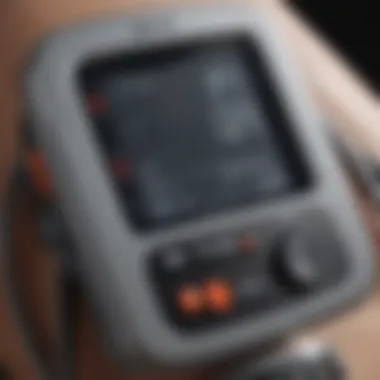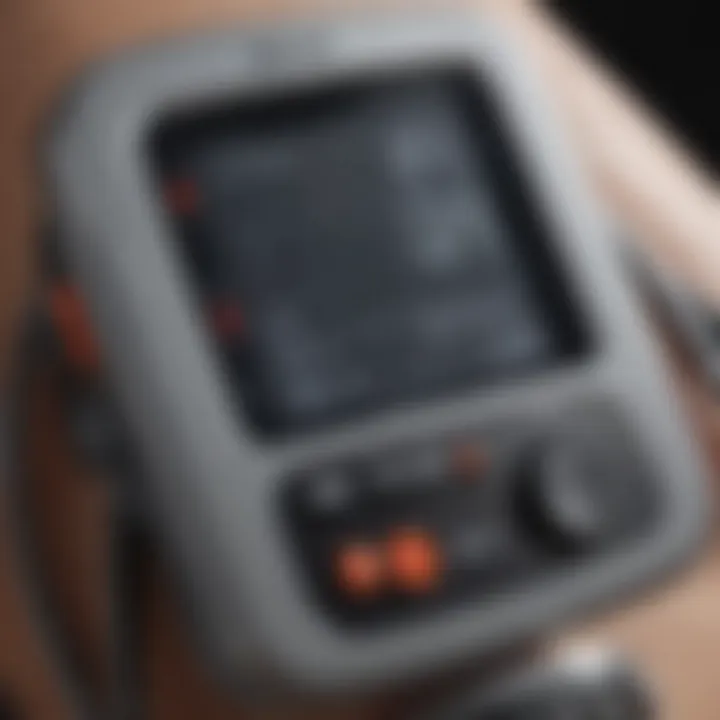Understanding Blood Pressure Measurement Techniques


Intro
Blood pressure measurement plays a crucial role in healthcare, as it helps assess cardiovascular health and identify various medical conditions. Correct understanding of the techniques and technologies used for blood pressure assessment is essential for both medical practitioners and patients. The topic encompasses a broad array of methods, from traditional to modern, that serve various needs and settings.
Background and Context
Overview of the Research Topic
Blood pressure (BP) reflects the force of blood against the walls of arteries. Accurate measurement is vital for diagnosing hypertension and other cardiovascular issues. Traditional methods, such as the auscultatory technique, have evolved with technological advancements to provide reliable readings. Understanding these methods allows individuals to make informed health decisions.
Historical Significance
Historically, blood pressure measurement has progressed significantly. In the late 19th century, Samuel Siegfried Karl von Basch developed the first sphygmomanometer. This device laid the groundwork for modern blood pressure monitoring. Over time, techniques have advanced into digital sensors, which improve on simplicity and accuracy.
Key Findings and Discussion
Major Results of the Study
Recent studies have shown that non-invasive methods, including oscillometric devices, are not only convenient but also provide comparable accuracy to traditional auscultatory methods. The development of continuous blood pressure monitoring devices has changed the landscape of cardiovascular monitoring, particularly in critical care.
Detailed Analysis of Findings
- Non-Invasive Techniques: These methods include arm cuff devices that are user-friendly and provide immediate feedback. Their accuracy is often validated against more complex methods. Digital monitors can simplify monitoring for patients at home and that is crucial for managing chronic conditions.
- Invasive Methods: While less common for routine use, invasive blood pressure measurement remains essential in critical care settings. It includes direct monitoring via catheterization, which provides real-time data on the patient’s hemodynamic status.
- Technological Advancements: Innovations such as wearable devices have enhanced home monitoring. Continuous non-invasive blood pressure monitors are becoming more available, improving patient accessibility to accurate data.
These findings highlight the importance of selecting the appropriate method based on the clinical scenario and patient needs. Understanding the methods available allows for better interpretation of readings and guides treatment decisions.
"A thorough understanding of blood pressure measurement techniques is essential in the advancement of effective health management."
This exploration into blood pressure measurement aims to equip readers with insight into the different methodologies and technologies, ultimately enhancing their ability to manage and understand this critical aspect of health.
Prelude to Blood Pressure
The measurement of blood pressure is a critical aspect of cardiovascular health assessment. Blood pressure indicates the force exerted by circulating blood against the walls of the arteries. The understanding of this concept is key to monitoring individual health status effectively. Blood pressure management can prevent serious health complications, including heart attacks and strokes.
Defining Blood Pressure
Blood pressure is defined as the product of cardiac output and systemic vascular resistance. Each heartbeat forces blood through the arteries. This force is measured as two values: systolic pressure and diastolic pressure.
- Systolic pressure measures the force during a heartbeat.
- Diastolic pressure assesses the force when the heart rests between beats.
Normal blood pressure is typically around 120 over 80 millimeters of mercury (mmHg). This standard is vital because deviations may indicate health issues. For example, hypertension, characterized by consistently high measurements, can lead to severe health risks. Conversely, low blood pressure, or hypotension, may also present complications such as dizziness or fainting. Thus, accurately defining and understanding blood pressure is fundamental in healthcare.
Physiological Importance of Blood Pressure
Blood pressure plays a significant physiological role. It aids in the delivery of oxygen and nutrients to tissues throughout the body. Proper blood flow is crucial for organ function and overall health. When blood pressure is appropriate, organs receive adequate blood supply, supporting metabolic needs. Conversely, abnormal blood pressure levels can strain organs.
Factors contributing to the physiological importance of blood pressure include:
- Regulation of blood flow: Blood pressure adapts based on physical activity, ensuring that muscles receive sufficient oxygen during stress.
- Impact on heart function: The heart adjusts its rhythm according to blood pressure, affecting how effectively it pumps blood.
- Homeostasis: Blood pressure helps maintain equilibrium across bodily systems, influencing fluid balance.
In summary, understanding the physiological importance of blood pressure is essential for grasping its implications in health management. Monitoring blood pressure can provide insight into cardiovascular risk and guide necessary interventions.
The Role of Blood Pressure Measurement
Blood pressure measurement plays a crucial role in healthcare. It serves as a primary indicator of cardiovascular health and overall well-being. Monitoring blood pressure can guide clinical decisions and interventions. It's essential for detecting conditions early and tailoring treatment plans effectively. Understanding blood pressure serves both individuals and healthcare professionals. It emphasizes the importance of regular checks in maintaining health.
Monitoring Health Status
Monitoring health status through blood pressure measurement offers many benefits. Regular measurements can help track changes in blood pressure over time, showing trends that are significant. Healthcare providers can use this information to intervene or adjust treatments when necessary.
Detecting hypertension or other abnormalities early can prevent more serious conditions. This proactive approach can drastically improve outcomes. Patients can become more engaged in their health, making lifestyle changes based on their blood pressure readings. Thus, continuous monitoring allows for timely responses to changing health conditions, ensuring a patient-centered approach to care.
Blood pressure can fluctuate due to various factors, such as stress, diet, and activity levels. This variability underscores the importance of regular monitoring rather than relying on sporadic readings. When patients understand their blood pressure patterns, they may modify their habits accordingly.
Assessing Cardiovascular Health
Assessment of cardiovascular health through blood pressure readings is vital. Blood pressure is a significant risk factor for heart diseases and strokes. Tracking these measurements helps identify at-risk individuals before serious complications arise.
High blood pressure, also known as hypertension, can lead to a host of problems if left unchecked. These can include heart failure, kidney disease, and more. Conversely, low blood pressure, or hypotension, can cause fainting and other complications.
Medical professionals categorize blood pressure into ranges to evaluate health risks:
- Normal: less than 120/80 mmHg
- Elevated: systolic between 120-129 mmHg
- Hypertension Stage 1: systolic between 130-139 mmHg or diastolic between 80-89 mmHg
- Hypertension Stage 2: systolic 140 mmHg or higher or diastolic 90 mmHg or higher
Understanding these categories equips patients and providers with information crucial for managing treatment plans. Regular assessment using accurate techniques enhances the ability to make informed decisions surrounding lifestyle modifications or medical interventions.
The integration of effective blood pressure measurement into routine healthcare practice cannot be overstated. It establishes a pathway towards preventing long-term complications, promoting education, and improving patient outcomes in the field of cardiovascular health.
Measurement Techniques
The measurement of blood pressure is a critical aspect of medical practice, influencing diagnosis and treatment across various health conditions. Choosing the right measurement technique ensures that the results obtained are both accurate and reliable. Understanding the capabilities and limitations of different methods is essential for healthcare professionals and patients alike. This section explores both non-invasive and invasive techniques, shedding light on their respective advantages and applications.
Non-Invasive Methods
Non-invasive methods of blood pressure measurement are widely used due to their ease of administration and patient comfort. Common tools include manual sphygmomanometers and digital blood pressure monitors, which require minimal training to operate effectively. The advantages of non-invasive methods are manifold:


- Accessibility: These devices can be used in various settings, including home care, outpatient clinics, and hospitals.
- Safety: Non-invasive methods pose no risk of complications such as infection or bleeding, which can occur with invasive techniques.
- Patient Comfort: Many individuals find non-invasive methods less intimidating compared to more invasive procedures.
However, these methods do have some considerations:
- Accuracy Variability: Factors such as cuff size, placement, and patient position can significantly influence readings. Careful adherence to guidelines is necessary to ensure consistency.
- Limited Applicability: In cases where accurate measurements are crucial, like in certain critical care situations, non-invasive methods might not provide the desired precision.
Invasive Methods
Invasive methods for measuring blood pressure involve instruments that penetrate the skin, often providing real-time, continuous monitoring. One common type is the intra-arterial blood pressure measurement, typically used in intensive care settings or during major surgeries. Here are key points regarding invasive techniques:
- Precision: Invasive methods yield highly accurate readings, which might be essential for patients with severe cardiovascular conditions.
- Continuous Monitoring: These techniques allow for real-time blood pressure tracking, enabling immediate clinical decision-making.
Nevertheless, they come with notable risks and drawbacks:
- Complications: Invasive procedures carry potential risks such as infection, arterial damage, and hematoma formation.
- Resource Intensive: The use of invasive methods often requires specialized equipment and trained personnel, limiting their applicability to specific clinical scenarios.
Invasive measurements provide critical insights in acute settings, yet they are accompanied by higher risks. Balancing precision with safety is key in selecting measurement methods.
Understanding both types of measurement techniques ensures that healthcare providers can optimize patient outcomes by selecting the most appropriate method in varying clinical contexts.
Sphygmomanometer: The Traditional Instrument
The sphygmomanometer is a cornerstone in the realm of blood pressure measurement. Its significance cannot be overstated, as it serves as a vital diagnostic tool in both clinical and home environments. Understanding how this instrument functions and the advantages it offers is crucial for anyone interested in studying blood pressure measurement techniques and technologies.
This device primarily measures arterial blood pressure by applying pressure to an artery and then releasing it while monitoring the sounds of blood flow. The reliance on sphygmomanometer stems from its accuracy and reliability, which are fundamental in assessing cardiovascular health. The manual and digital variations of this instrument cater to different user preferences and health care contexts. Not only does it assist in identifying conditions like hypertension, but it also plays an integral role in routine health assessments.
Manual Sphygmomanometers
Manual sphygmomanometers, often referred to as aneroid sphygmomanometers, require a trained professional for accurate readings. They utilize a simple design, featuring a cuff, a pressure gauge, and a bulb for inflation. The clinician inflates the cuff to constrict the artery, then gradually releases the pressure while listening with a stethoscope to hear distinct sounds, known as Korotkoff sounds.
Using a manual sphygmomanometer has several benefits:
- Accuracy: When properly used, these devices provide highly accurate readings.
- Cost-effective: Manual devices tend to be more affordable compared to their digital counterparts.
- Less dependency on technology: They do not require batteries or electronic components, making them reliable in various settings.
However, there are considerations. Manual devices require good technique and experience to ensure accurate results. There is also the potential for human error when interpreting the measurements. Despite these drawbacks, their use remains prevalent in many clinical settings, especially in environments where technology may not be as accessible.
Digital Sphygmomanometers
Digital sphygmomanometers represent a significant advancement in blood pressure monitoring technology. These devices automate the measurement process, providing readings at the push of a button. They usually feature an LCD screen, which displays blood pressure readings and heart rate in a straightforward manner.
The advantages of digital sphygmomanometers include:
- Ease of use: They are user-friendly and often recommended for home monitoring.
- Quick results: Digital devices provide readings instantly, reducing the time involved in measuring blood pressure.
- Data management: Many digital models have the capability to store previous readings, aiding users in tracking their blood pressure over time.
Nevertheless, it is essential to approach digital sphygmomanometers with caution. They may be less accurate for certain populations, like those with arrhythmias. Calibration and regular maintenance are crucial to ensuring their reliability. Additionally, some individuals may find themselves overly reliant on these devices, ignoring traditional methods of measurement that build a deeper understanding of their blood pressure status.
Advancements in Blood Pressure Measurement Technology
The landscape of blood pressure measurement is evolving rapidly. These advancements are not just about innovation; they represent a crucial shift towards more accurate, convenient, and comprehensive monitoring of cardiovascular health. The integration of technology into blood pressure measurement can enhance the reliability of readings, reduce the margin for error, and ultimately contribute to better health outcomes.
Wearable Technology
Wearable technology has gained significant traction in the healthcare sector. Devices like smartwatches and fitness trackers have incorporated blood pressure monitoring as a standard feature. This integration allows users to keep track of their readings throughout the day without the need for cumbersome equipment.
Benefits of wearable technology include:
- Continuous Monitoring: Unlike traditional devices that provide a single snapshot, wearables can offer a continuous stream of data, making it easier to identify trends.
- User-Friendly Interface: Most wearable devices are designed with user experience in mind. They often come with intuitive apps that display data visually, making it accessible for everyone.
- Data Integration: Many devices allow sync with online health platforms. This feature enables users to share their data with healthcare providers easily, streamlining diagnosis and treatment.
"Wearable technology empowers patients to take a proactive role in their health management."
Mobile Health Applications
Mobile health applications serve as an extension of wearable technology. These applications enhance the functionality of blood pressure monitoring by offering tools for data collection, analysis, and sharing. A well-designed mobile app can amplify the effectiveness of home monitoring.
Key considerations for mobile health applications include:
- Data Visualization: Apps can transform complex data into easy-to-understand visual formats. This simplification encourages users to engage more with their health metrics.
- Reminders and Alerts: Many apps provide customizable reminders for users to take their blood pressure or follow specific healthcare protocols. This feature plays a vital role in patient adherence.
- Educational Resources: Some applications include a library of resources that educate users about hypertension, its risks, and management strategies to promote better understanding and health literacy.
In summary, the advancements in blood pressure measurement technology, particularly through wearable devices and mobile applications, are redefining how individuals monitor their health. These technologies not only improve accuracy but also enhance patient engagement, ultimately leading to improved health outcomes.
The Importance of Accurate Measurements
Accuracy in blood pressure measurement is vital for effective diagnosis and management of health conditions. Blood pressure readings are not merely numbers; they are indicators of cardiovascular health, metabolic state, and overall physiological function. Inadequate accuracy can lead to misdiagnosis, inappropriate treatment, and the potential for serious health consequences.
One of the central elements affecting the importance of accurate measurements is the clinical decision-making based on these readings. Healthcare providers frequently rely on blood pressure data to evaluate a patient’s health status. An incorrect reading can mislead providers, resulting in either unnecessary anxiety for patients or a failure to address critical health issues. Therefore, ensuring reliable measurements impacts patient safety directly.
Benefits of Accurate Measurements:
- Guiding Treatment: Precise blood pressure readings allow for appropriate treatment plans tailored to individual health requirements.
- Monitoring Progress: Reliable data help in tracking the effectiveness of prescribed interventions over time.
- Preventing Complications: Accurate assessments can prevent the long-term complications associated with hypertension, such as stroke and heart attack.
However, accuracy is influenced by several factors that healthcare professionals must consider regularly. Let’s delve deeper into these factors.
Interpreting Blood Pressure Readings
Understanding how to interpret blood pressure readings is crucial, as it helps in recognizing individual health conditions and managing potential health risks. Blood pressure measurements reveal vital information about the functioning of the cardiovascular system. High or low readings can indicate underlying health issues demanding attention. This section aims to clarify essential blood pressure components, ranges, and how to identify health concerns related to hypertension and hypotension.


Understanding Blood Pressure Ranges
Blood pressure is measured in millimeters of mercury (mmHg) and it consists of two values: systolic and diastolic pressure.
- Systolic pressure is the pressure in arteries when the heart beats.
- Diastolic pressure is the pressure when the heart rests between beats.
Blood pressure can be categorized into several ranges as follows:
- Normal: Below 120/80 mmHg
- Elevated: 120-129/80 mmHg
- Hypertension Stage 1: 130-139/80-89 mmHg
- Hypertension Stage 2: 140 or higher/90 or higher mmHg
- Hypertensive Crisis: Higher than 180/higher than 120 mmHg
Each range indicates progressively serious implications for health. Normal readings indicate a lower risk of heart disease and stroke, while elevated and high blood pressure levels suggest increased health risks. Recognizing these ranges is vital to taking preventive measures or implementing treatment when necessary.
Identifying Hypertension and Hypotension
Hypertension, commonly referred to as high blood pressure, often has no noticeable symptoms, making it difficult to detect without regular monitoring. Understanding the classification is key:
- Hypertension is characterized by consistently elevated readings. It can lead to severe complications, such as heart attack or stroke, if left untreated.
- Hypotension, or low blood pressure, may present symptoms such as dizziness or fainting, often requiring immediate medical attention especially if it leads to injury or falls.
Identification entails not only recognizing the blood pressure numbers but also understanding the significance of sudden changes in these values. A single high reading may not necessarily indicate hypertension. Generally, a diagnosis requires multiple readings that confirm elevated levels.
Regular monitoring and awareness of one's blood pressure readings are essential to maintaining cardiovascular health.
The Clinical Role of Blood Pressure Measurement
Blood pressure measurement serves a pivotal role in clinical practice. Regular monitoring is essential for detecting cardiovascular conditions, guiding treatment decisions, and managing patient care effectively. Understanding how these measurements are integrated into clinical settings not only highlights their importance but also informs best practices that ultimately enhance patient outcomes.
Standard Protocols in Clinical Settings
In clinical environments, adherence to standard protocols for blood pressure measurement is crucial. These protocols ensure consistency, reliability, and accuracy of readings. Medical staff are trained to follow specific guidelines which include:
- Patient Preparation: Patients should be seated comfortably, ideally in a calm environment. A period of rest is recommended prior to taking readings to reduce anxiety-induced variance.
- Choosing the Right Equipment: Selecting appropriate devices, whether manual or digital, is important to ensure accurate measurements.
- Arm Positioning: The patient's arm should be at heart level. This position aids in obtaining an accurate reading reflective of true blood pressure.
- Multiple Readings: Taking multiple readings and averaging them is a common practice. This method accounts for variability and ensures more consistent results.
Following these standardized procedures can decrease the likelihood of errors and improve the assessment of a patient’s blood pressure.
Integration with Patient Records
Integrating blood pressure measurements with electronic health records (EHR) is becoming increasingly important. This integration allows for seamless tracking of a patient’s history and facilitates informed clinical decision-making. Some advantages of this integration include:
- Longitudinal Tracking: Health professionals can view blood pressure trends over time. This information is critical for diagnosing hypotension or hypertension and for monitoring treatment efficacy.
- Data Accessibility: Integrated records make it easy for different healthcare providers to access essential data without needing to duplicate measurements. This can enhance coordination between specialists.
- Alerts and Reminders: EHRs can be programmed to alert physicians when a patient’s readings fall outside normal ranges, prompting timely intervention.
Ultimately, the clinical role of blood pressure measurement is enhanced through these best practices and technologies. As healthcare continually evolves, the integration and accuracy of blood pressure readings underscore their significance in promoting patient health.
Home Blood Pressure Monitoring
Home blood pressure monitoring is becoming increasingly significant in maintaining cardiovascular health. It offers patients greater understanding and control over their blood pressure outside of clinical settings. This practice not only empowers individuals but also provides healthcare professionals with valuable data for diagnosis and treatment. In this section, we explore the devices available for home use and the best practices for monitoring.
Devices for Home Use
Several devices are available for individuals looking to monitor their blood pressure at home. These devices typically fall into two categories: automatic and manual.
- Automatic Digital Monitors: These devices are user-friendly. They usually require little training. Users wrap a cuff around their upper arm or wrist, and with a simple push of a button, the machine will take a reading. Popular models include the Omron Platinum Blood Pressure Monitor.
- Manual Monitors (Sphygmomanometers): These require a stethoscope and are more technical to operate. This type might appeal to those who prefer traditional methods. Nonetheless, they demand proper technique to ensure accurate readings.
- Smartphone Applications: Emerging mobile applications offer a clever solution. They collect data from smart monitors and allow users to track readings over time. Some well-known apps include Blood Pressure Monitor by Leap Fitness Group.
Each type has distinct advantages and some limitations. For example, automatic monitors can be misread due to user error, while manual monitors require skill but can be more accurate when used correctly.
Guidelines for Home Monitoring
Monitoring blood pressure at home requires some guidelines to ensure effectiveness and reliability.
- Choose the Right Device: Select a device validated for accuracy. Review user feedback and consult healthcare providers for recommendations.
- Consistency in Measurement: Take readings at the same time daily. Consistent timing provides a better picture of blood pressure trends. Avoid measuring after heavy meals, caffeine, or exercise, as these factors can skew results.
- Proper Positioning: Sit quietly for five minutes before measuring. Keep your back supported and feet flat on the floor. The arm should be at heart level, resting on a table.
- Record Your Readings: Keeping a log will help track changes over time. Note the time of day, reading, and any related symptoms. This information can be crucial for healthcare providers.
- Follow-Up with Health Professionals: Share your home readings with your healthcare professional. This continuity helps them adjust treatment plans if necessary.
"Self-monitoring empowers patients. It offers real-time feedback on their health, ultimately driving engagement in their care journey."
Challenges in Blood Pressure Measurement
Understanding the challenges inherent in blood pressure measurement is critical in appreciating the complexities of accurately assessing an individual's health. Accurate measurements can significantly influence treatment decisions and health outcomes. However, various factors can complicate the blood pressure measurement process, leading to errors that might affect the reliability of the readings. Addressing these challenges helps improve patient care and ensures that clinicians make informed decisions.
Patient Anxiety and Measurement Accuracy
One significant challenge in blood pressure measurement is the impact of patient anxiety on results. When patients approach a clinical setting, they often experience nervousness. This anxiety can trigger a temporary increase in blood pressure known as 'white-coat syndrome.' During measurement, even a slight elevation can lead to an inaccurate representation of a patient's true blood pressure status.
To mitigate this issue, healthcare providers can implement soothing techniques. Allowing patients time to relax before measurements can result in more accurate readings. Additionally, educating patients about the importance of blood pressure monitoring can help reduce anxiety levels during visits.
Consider these approaches to address patient anxiety:
- Pre-appointment education: Inform patients about what to expect during their visit.
- Comfortable environments: Ensure that the measurement area is quiet and calming.
- Adjust measurement techniques: Use a relaxed position and avoid abrupt cuff inflation.
Research indicates that addressing patient anxiety can significantly lower blood pressure readings, enhancing the overall accuracy of monitoring processes.
Variability in Readings
Blood pressure readings can vary for several reasons, complicating the challenge of achieving consistent measurements. Variability may arise from physiological factors, such as changes in hydration status, stress levels, and recent physical activity. External factors can also play a role, including the time of day and even the temperature of the measurement environment.
Variability can be classified into two categories:
- Intra-individual variability: Differences within the same individual over time.
- Inter-individual variability: Differences across individuals due to diverse physiological backgrounds.


To minimize the impact of variability, standardized guidelines should be strictly adhered to for each measurement session. Key strategies include:
- Measuring at the same time each day: Consistency in timing helps negate daily fluctuations.
- Avoiding stimulants before measurement: Patients should refrain from caffeine and exercise prior to checks.
- Multiple readings: Taking several readings within a single session can help average out fluctuations for a more reliable result.
In summary, the challenges in blood pressure measurement are crucial in establishing accurate health assessments. By understanding the effects of patient anxiety and reading variability, healthcare providers can implement strategies to enhance measurement reliability, ultimately benefiting patient care.
Future Directions in Blood Pressure Measurement
As the understanding of blood pressure measurement evolves, so do the methods and technologies employed. This section highlights the importance of future developments in this vital area of healthcare. A focus on innovative approaches can enhance the accuracy and accessibility of blood pressure monitoring. Technologies that improve measurement reliability will significantly impact patient outcomes. For researchers and healthcare professionals, staying abreast of these trends is crucial for informed decision-making.
Emerging Technologies
The landscape of blood pressure monitoring is increasingly influenced by advancements in technology. Innovations like smart wearable devices are at the forefront, providing continuous monitoring capabilities. These devices enable users to track their blood pressure in real time. For instance, products from companies like Omron and Fitbit have emerged, combining traditional measurements with modern technology.
Such devices often integrate with smartphones through specialized applications, allowing users to analyze their readings over time. The implications of this are profound. Users can detect patterns and anomalies, leading to proactive healthcare choices.
Additionally, innovative sensors are being developed that assess a patient's blood pressure through non-invasive means. These technologies utilize ultrasound or optical methods, which could revolutionize routine check-ups by eliminating the need for cuffs.
Prospective developments in artificial intelligence may also play a role. By analyzing large datasets from user readings, AI could help predict potential health issues.
Research Trends in Measurement Techniques
Current research focuses on refining existing measurement techniques and exploring new methodologies. Studies are underway to improve the accuracy of ambulatory blood pressure monitoring systems. These systems allow for measurements over an extended period, capturing variability in blood pressure that a single measurement would miss.
Moreover, there is a growing interest in personalized medicine. Research explores how individual factors, such as genetics, diet, and lifestyle, can affect blood pressure and its measurement.
Another trend is the integration of blood pressure data with electronic health records. This will provide a complete view of patient health, promoting a more comprehensive approach to treatment.
There are ongoing discussions about establishing standardized protocols for home monitoring, aimed at reducing discrepancies in measurement due to various factors like posture and anxiety. The focus on patient education will be pivotal in this area.
"Future advancements in technology and research are essential for refining blood pressure measurement, directly impacting patient care and outcomes."
The Impact of Lifestyle on Blood Pressure
Understanding the impact of lifestyle on blood pressure is crucial for maintaining cardiovascular health. Poor lifestyle choices can significantly contribute to the risk of developing hypertension and other related conditions. Conversely, positive lifestyle modifications can act as protective measures. This section will explore the components of diet and nutrition, as well as exercise and physical activity, and their correlation with blood pressure regulation.
Diet and Nutrition
Diet plays a significant role in blood pressure management. Certain foods can lead to elevated blood pressure, while others may help lower it. A diet high in saturated fats, sugared beverages, and processed foods can increase weight and exacerbate hypertension. On the other hand, foods rich in potassium, magnesium, and omega-3 fatty acids are associated with lower blood pressure levels.
Key points to consider in diet and nutrition include:
- DASH Diet: Following the Dietary Approaches to Stop Hypertension diet emphasizes fruits, vegetables, whole grains, and lean proteins. This diet can lower blood pressure effectively.
- Salt intake: Reducing sodium is essential. High sodium intake can cause the body to retain water, which increases blood volume and subsequently blood pressure.
- Alcohol moderation: Excessive alcohol consumption has a direct link to higher blood pressure. Thus, moderation is needed.
Studies suggest that individuals who adopt a heart-healthy diet observe a significant improvement in their blood pressure readings.
Exercise and Physical Activity
Regular physical activity is another essential factor in blood pressure control. Engaging in moderate aerobic exercises strengthens the heart muscle, enables the heart to pump blood more efficiently, and can reduce both systolic and diastolic blood pressure. The recommendation is to aim for at least 150 minutes of moderate-intensity exercise weekly.
Benefits of exercise include:
- Weight management: Maintaining a healthy weight through exercise can reduce the incidence of hypertension.
- Improved circulation: Exercise helps improve blood circulation, thus reducing blood pressure over time.
- Stress reduction: Physical activity is a natural stress reliever, which can lower cortisol levels and help manage blood pressure.
In summary, lifestyle choices regarding diet and exercise significantly impact blood pressure regulation. Encouraging individuals to adopt healthier habits may not only reduce the risks associated with hypertension but also enhance overall well-being.
Educating Patients on Blood Pressure Monitoring
Educating patients on blood pressure monitoring is crucial for overall health management. Patients often have limited understanding of blood pressure’s significance, which can hinder effective self-management. They might underestimate the relevance of monitoring. Education helps to clarify how blood pressure influences cardiovascular health, providing patients with practical information they can apply in daily life.
The Role of Healthcare Providers
Healthcare providers play a pivotal role in patient education. They must communicate effectively the importance of regular blood pressure checks. Practitioners can personalize discussions around individual health risks and benefits of monitoring. They should promote understanding of reading results and their implications, ensuring patients grasp the difference between normal, elevated, and hypertensive levels. It is essential for healthcare professionals to foster an environment of encouragement, making patients feel comfortable asking questions related to their blood pressure. This interaction not only builds trust but also enhances adherence to monitoring regimens.
Key responsibilities for providers include:
- Discussing measurement techniques: Educate patients on how to accurately use monitoring devices at home.
- Providing tailored advice: Tailor information based on the patient’s specific health conditions or lifestyle.
- Establishing follow-up routines: Suggest regular follow-ups to discuss blood pressure trends.
"Education empowers individuals to take control of their health decisions."
Patient Empowerment Strategies
Empowering patients through education involves equipping them with knowledge and tools to monitor their blood pressure effectively. One strategy is teaching patients how to use digital sphygmomanometers properly. Practical demonstrations enhance retention and confidence. Additionally, healthcare providers should emphasize lifestyle modifications; altering diet and engaging in physical activity can positively impact blood pressure control.
Resources such as mobile health applications can assist patients in tracking their readings over time. Encouraging the use of these tools allows patients to visualize trends, motivating them to maintain or improve their health.
Moreover, healthcare professionals should advocate support groups or community resources where patients can share experiences. This collaborative environment reinforces learning and encourages accountability. Ultimately, patient empowerment can lead to improved blood pressure control and better health outcomes.
Epilogue
Understanding blood pressure measurement is a critical aspect of healthcare. This article has explored various techniques and technologies used in measuring blood pressure, underscoring their significance in evaluating cardiovascular health. The methods discussed range from traditional sphygmomanometers to advanced digital devices and wearable technology, highlighting how each contributes to more accurate readings.
Accurate blood pressure measurement is crucial for diagnosing conditions like hypertension and hypotension. Misreadings can lead to inappropriate treatment strategies, which can exacerbate health issues. By grasping the fundamental concepts surrounding blood pressure and its implications, patients and healthcare providers can work collaboratively for improved health outcomes.
Summary of Key Points
- Importance of Accurate Measurements: Blood pressure readings must be precise to inform treatment decisions effectively.
- Diverse Techniques: A variety of methods exist, each with advantages and disadvantages based on the situation. Non-invasive methods are preferable for regular monitoring, while invasive techniques may be needed for specific cases.
- Technological Advancements: Innovations in technology facilitate better monitoring practices, allowing patients to track their health in real-time and enhancing clinical efficiency.
- Patient Education: Increasing awareness about blood pressure measurement empowers patients, resulting in better healthcare engagement and outcomes.
The Future of Blood Pressure Measurement
The future of blood pressure measuring looks promising with the integration of new technologies. Research is focused on creating even more reliable devices that can provide continuous monitoring. This can lead to personalized health management and improved lifestyle interventions. Wearable technology, such as smartwatches, are trending to become standard devices in managing blood pressure.
Advancements in artificial intelligence and machine learning could enhance data interpretation, helping doctors to analyze trends over time rather than isolated readings. This could help identify potential health issues before they become serious. Furthermore, collaborations between tech companies and healthcare professionals will likely drive innovation in this field, ensuring that monitoring remains effective, accessible, and user-friendly.







